|
An amazing
200-meter-long crop picture appeared in eastern France on June 13, 2019
near the small town of Saint-Hippolyte. It was drawn within a “horse”
shape in the landscape, in accord with the historical legend of
Hippolytus from ancient Rome, and points toward a small town which bears
his name.
A new,
200-meter-long crop picture appeared mysteriously in eastern France
(near its border with Germany) on June 13, 2019. It was drawn as two
separate parts in two adjoining fields of green wheat. The farmer and
his colleagues say that they saw no one there, before they found it
early in the morning.
This crop
picture was drawn within a large “horse” shape in the landscape, and
points toward the small town of Saint-Hippolyte 1 km away
Quite
amazingly, this two-part crop picture was drawn within a large “horse”
shape in the landscape, that can only be seen using Google Earth or from
high in the air:
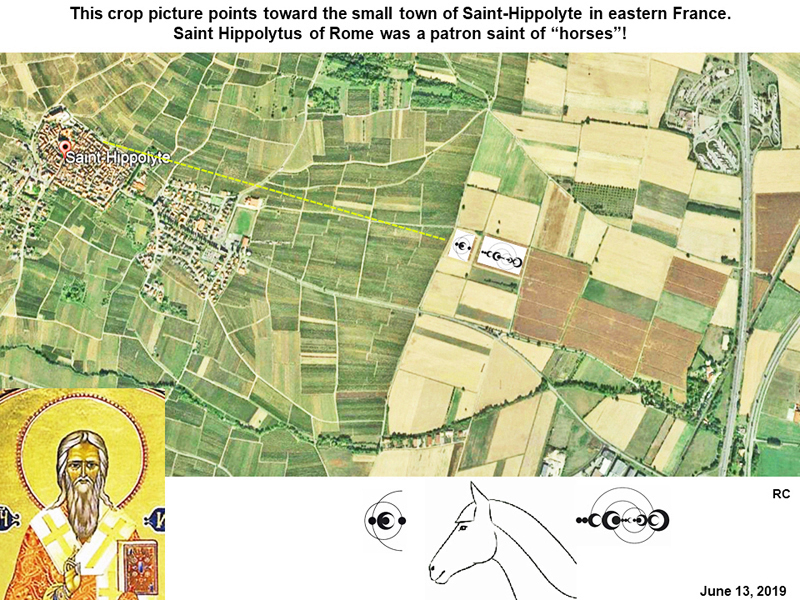
It also
points along crop tramlines toward the small town of Saint-Hippolyte
nearby (see
Saint-Hippolyte,_Haut-Rhin). Please see a thin, dashed
yellow line in the slide above, to
study this long-distance alignment. We can see the same long-distance
alignment in a large aerial photograph of the new crop picture, posted
at the top of this news article (see
/un-immense-crop-circle-decouvert-dans-les-bles-pres-de-colmar).
Interestingly enough, the new crop picture seems to have been drawn
close to the “eye” of that figurative “horse” shape in the landscape.
Our equine friend seems to be “looking at” the town of Saint-Hippolyte
from 1 km away! Please examine the right-hand end of a dashed
yellow line, in the slide above, to
see this clever artistic feature? Saint Hippolytus in the Middle Ages
was known as a “patron saint of horses”.
That
landscape “horse” can “see” the small town of Saint-Hippolyte, and may
be on its way to reach there soon
As shown in
another slide below, the detailed form of this new crop picture suggests
that our landscape “horse” can “see” the small French town of Saint-Hippolyte,
named after Hippolytus of Rome. Thus the left-hand part of this crop
picture resembles a schematic drawing of a horse’s “two eyes” and broad
“visual field of sight”:
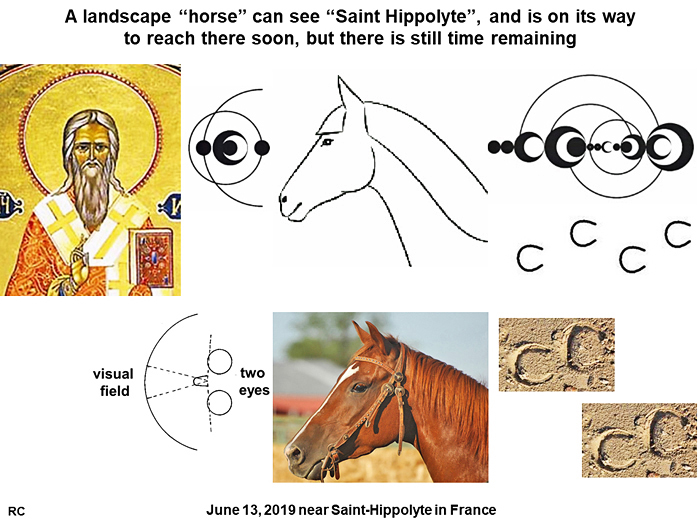
Its
right-hand side likewise resembles the “hoof marks” made by a horse, as
it walks forward in the sand (although other interpretations are
possible). How long will it take that landscape “horse” to reach “Saint
Hippolyte”?
The clever
double-meaning of a “Venus calendar”, composed of “circles” and
“crescents”
When this
two-part crop picture is studied from an astronomical perspective, it
seems to show a “Venus-phase calendar” which will end about 16 months
from now. There will be two Venus-Sun-Earth alignments (or conjunctions)
in the near future on August 14, 2019 (superior), then on June 4, 2020
(inferior). We can see plausible symbols for both in the two-part crop
picture as shown below:
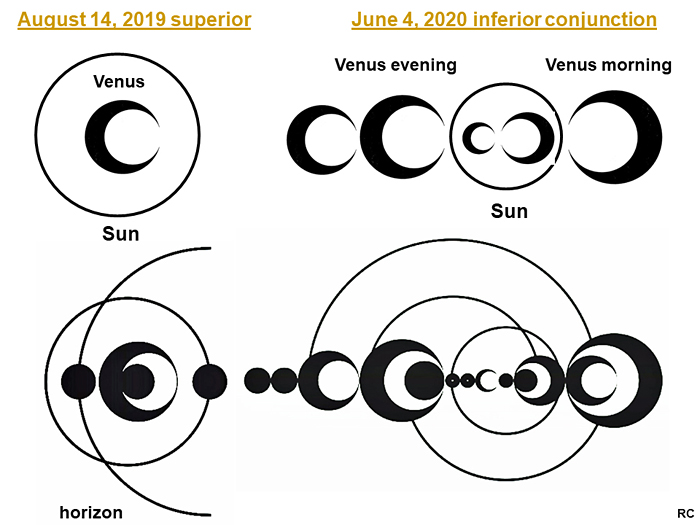
Each part
(left or right) shows a large, thin circular shape for our “Sun”. Planet
“Venus” seems to be represented by a “crescent”, whose size depends on
its relative brightness in Earth’s sky over time. After its second
conjunction with our Sun in June of 2020, Venus will grow brighter over
several months, and then this particular crop-drawn calendar will end.
Three long,
curved lines seem to connect similar crescent-phases for Venus, just
before or after inferior conjunction on June 4, 2020. Similar
connecting-lines were drawn in crop pictures at Forest Way on July 17,
2014 (see
roydon 2014l )
or July 24, 2016 (see
forests way 2016l ).
Who was
Saint Hippolytus in ancient Rome?
Saint
Hippolytus of Rome was a Christian scholar-pope, who lived in the first
half of the 3rd century AD. He is remembered today for
studying the rise of the Antichrist, and eventual return of Jesus
Christ, by Biblical prophecy (see
Hippolytus_of_Rome or
hippolytus_commentary-on-daniel).
Many sources
suggest that Saint Hippolytus was martyred for Christ, through being
pulled apart by wild horses (see
hippolytus). The two words “hippos” and “lytus” which make up
his name mean “horse” and “destroyed” in Greek. There was likewise a
mythological “Hippolytus”
in ancient Athens,
who was believed to have been dragged to
his death by wild horses.
The
very-large landscape image of a “saint” who is “praying on his knees”
We can also
see, using Google Earth, a very-large landscape image, overlapping the
town of Saint-Hippolyte, of a “saint” who is “praying on his knees”
(shown on the left below):
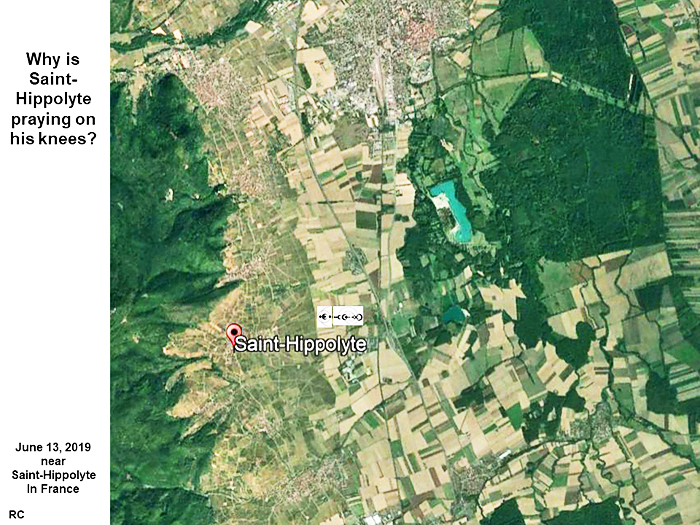
On the
right, we can see the very-large landscape image of a “human skull” with
a large “blue eye”.
Why did the
crop artists choose this particular field location for their June 13
crop picture? Perhaps to suggest that a “saint”, who is “praying on his
knees”, may be in fear of “death from martyrdom”, even as a landscape
“horse” (marked by two small, white, inserts for the new crop picture)
approaches that “saint” from behind?
The artistic
and landscape symbolisms used in this crop picture seem to be based on a
legend about Saint Hippolytus in ancient Rome
In summary,
we have a new and spectacular crop picture which appeared near a small
town in France called “Saint Hippolyte”. It points toward that small
town in the distance about 1 km away.
Furthermore,
this new crop picture was drawn close to the “eye” of a distinct “horse”
shape in the landscape. That figurative “horse” seems to be “looking at”
the small town of Saint-Hippolyte, even as it heads in the same
direction.
An
astronomical “Venus calendar”, drawn there in crops, suggests that this
metaphorical “horse” may reach “Saint-Hippolyte” in the late summer or
autumn of 2020.
The
historical Hippolytus of Rome supposedly died as a Christian martyr,
after being pulled apart by wild horses. Of possible relevance,
we can also see there the very-large landscape image of a “saint” who is
“praying on his knees”, apparently out of fear of death by martyrdom.
Why did some
unseen crop artists draw this amazing, 200-meter-long field-picture near
the small town of Saint-Hippolyte in remote, rural France? Perhaps other
“wild horses” are coming soon to metaphorically “pull apart” other
Christian leaders of our day, and they wished to warn us with an
unforgettable and clever message:
“Wild horses
are coming again soon for modern people like Saint Hippolyte, just as
they did in ancient Rome.”
Do those
crop artists know much about the ancient history of Earth? It would seem
so, since they left another memorable message in Latin of “timeo ET
ferentes!” in a field near Torino Airport in 2015 (see
Aeroporto comments ).
Should we be
praying now in the summer of 2019?
Should we
all be praying now in the summer of 2019, just as we can see Saint-Hippolyte
doing in a landscape slide shown above? That is what those unseen
artists suggested in crops at Chesterton Farm on May 25, 2019. There
they drew a small string of Christian “prayer beads”, near a landscape
Christian “cross” (see
Chesterton articles ).
This new
crop picture which appeared in France near Saint-Hippolyte on June 13,
2019 was undoubtedly real, as was another beautiful crop picture
which appeared near Moisselles on June 1 (see
notre articlesl ).
Were both field pictures made by benevolent, unseen entities whom we
call “angels”? One might think so! Sometimes you just have to believe in
things which you cannot see.
Anyone
skilled at the art of making crop-circles can study this ground-video,
taken at Saint-Hippolyte on June 13, to see there the clear signs of a
200-meter-long field-image which was not made by men with “rope
and boards” (see
crop-circles-c-est-impressionnant-de-voir-ca-a-cote-de-chez-nous).
To believe otherwise would be to place a “hypothesis before the facts”,
or a “cart before the horse”.
Another image of the letter “Q” may be seen at Saint-Hippolyte in 2019,
just like at Sarraltroff in 2018
Finally, is there any definite evidence as to who may have made this new
crop picture at Saint-Hippolyte in 2019? It shows 4 linear symbols
(small circles or crescents) on the left, and 13 other linear symbols
(small circles or crescents) on the right. Thus there are 17 of these
symbols in total, drawn along crop tramlines. Could the unseen artist be
someone with an initial of “Q” as for the 17th letter of the
alphabet?
In the aerial photograph shown below, we can see how a subtle image of
the letter “Q” has been included within the crop picture at Saint-Hippolyte,
by drawing a large-downward-facing “crescent”, slightly above and to the
left of some “curved” features in standing green wheat, which then make
its “curvy tail”:
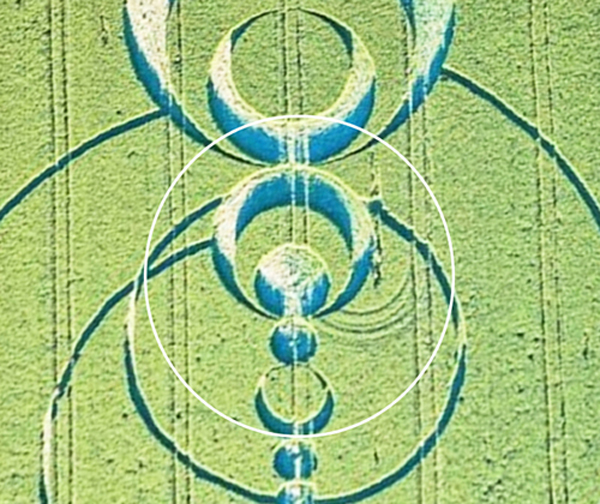
Another crop
picture in France near Sarraltroff on June 11, 2018 was likewise drawn
in the shape of a large letter “Q” (see halfway down the page on
Sarraltroff articlesl ).
What are the
odds of that? Coincidence? Two crop-drawn letters which resemble “Q”?
Think “68-95-99.7 rule” (see
wikipedia).
Many of us
pointed out at the time, that some highly-vocal claims by a group of
debunkers to have made the “Q” crop picture at Sarraltroff, two
months later in August of 2018, were just an elaborate,
computer-graphics-based deception (see the first titled section
on
http://www.cropcircleconnector.com/2018/Sarraltroff/comments.html ).
Now in 2019, after this beautiful and mysterious crop picture has
appeared near Saint-Hippolyte, way out in an unvisited rural region of
eastern France, and shows subtly another letter “Q”, the majority of
French people should be able to understand the truth, which will set
them free.
Red Collie
(Dr. Horace R. Drew) |